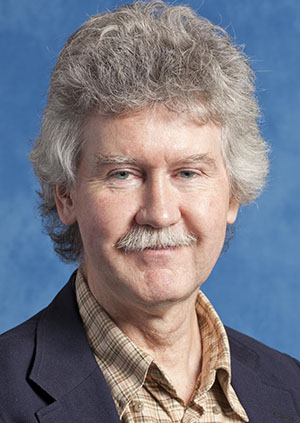
Robinson is a pioneer in Bragg coherent diffraction imaging, an important capability for the upgraded Advanced Photon Source.
A pioneer in the field of X-ray diffraction techniques has been recognized with the Arthur H. Compton Award, given every two years by the Users Executive Committee of the Advanced Photon Source (APS), a U.S. Department of Energy (DOE) Office of Science user facility at DOE’s Argonne National Laboratory.
Ian Robinson, a professor at University College London and scientist at DOE’s Brookhaven National Laboratory, is the 2025 recipient of the Compton Award. The award recognizes important scientific or technical accomplishments at the APS. It’s named after an American physicist who won the Nobel Prize in physics in 1927 for discovering the Compton Effect, which explains changes in X-ray wavelengths resulting from collisions with electrons.
Robinson pioneered a technique called Bragg coherent diffraction imaging (BCDI), which enables 2D or 3D reconstructions of images of crystalline structures at the nanoscale. The APS, which is in the final stages of a comprehensive upgrade, generates ultrabright and very coherent X-ray beams that are ideal for BCDI. Using these beams, scientists can gather data on the structures of nanoparticles and use those data to create reconstructed images.
Researchers use BCDI at the APS to visualize the behavior of battery electrodes as the devices charge and discharge, among other breakthroughs.
Robinson’s foundational studies into BCDI were conducted in the early 2000s, before coherent X-ray facilities such as the upgraded APS. Two decades later, his insights have led to BCDI’s use as a powerful technique across many scientific fields. Among the planned new beamlines at the APS is Atomic, which will be constructed at sector 34. Atomic will harness the upgraded facility’s brighter and more coherent X-ray beams for ultra-precise BCDI experiments.
Robinson was nominated for the Compton Award by Argonne Distinguished Fellow Khalil Amine of the Chemical Sciences and Engineering division. Amine has worked with Robinson for years on battery studies at the APS.
“Robinson’s remarkable achievements have not only deepened our fundamental understanding of materials but have also paved the way for future scientific advancements,” Amine wrote. “I am confident that his work will continue to inspire and drive progress in the field for years to come.”
Robinson began his career as an independent researcher at Bell Labs, developing a novel technique of Surface X-ray Diffraction (SXRD) that was widely used at light sources such as Brookhaven’s National Synchrotron Light Source (a DOE Office of Science user facility). In the late 1990s, he turned his attention to coherent X-ray diffraction at the APS and was instrumental in the construction of new beamlines at sector 34 to explore the technique.
“I am honored to receive the APS Compton Award, named after one of the pioneers of X-ray science,” Robinson said. “My contributions to the development of BCDI (named after another pioneer, William Henry Bragg) follow a strong tradition of instrument development that has been well-supported by the DOE and by the management of the APS. It follows a familiar path of translating the principles of visible light optics to the wavelength scale of X-rays and merging with instrumental engineering to match. I hope this recognition will help advance the applications of BCDI in the fields of physics, chemistry, engineering and medicine.”
